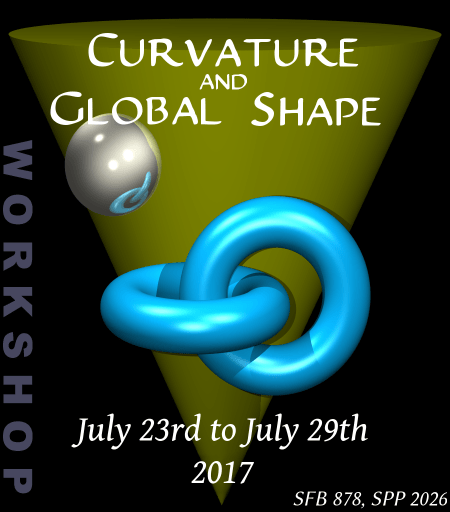Some impressions from the conference “Curvature and global shape” that took place July 24-28 in Münster.
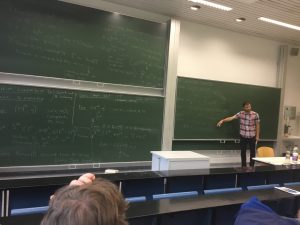
Lee Kennard (Oklahoma) talked about simply connected manifold with an action of an at least 5-dimensional torus. With Burkhard Wilking (Münster) he proves that they can have an invariant metric of positive sectional curvature only if the Euler characteristic is positive.

Anna Siffert (Bonn) discussed metrics on closed surfaces which realize the maximum of the first eigenvalue of the Lapace operator among aöö metrics of area normalised to 1. With Henrik Matthiesen (Bonn) she proves that one can realize this maximum by a smooth metric with finitely many conical singularities.

Luigi Verdiani (Florenz) erklärte zunächst mit verschiedenen Beispielen die Geometrie von Kohomogenität-1-Mannigfaltigkeiten, also von Mannigfaltigkeiten mit einer Gruppenwirkung, bei der ein (und demzufolge fast alle) Orbiten Kodimension 1 haben, und diskutierte dann seine Arbeit mit Wolfgang Ziller (Pennsylvania) betreffs der Konstruktion von Metriken mit vorgegebener (gruppeninvarianter) Ricci-Krümmung auf solchen Mannigfaltigkeiten.
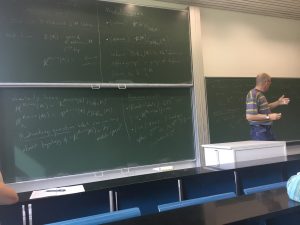
David Wraith (Maynooth) proves that for all k und large n there are elements of infinite order in the 4k-th homotopy group of the moduli space of Ricci-positive metrics on the n-sphere.
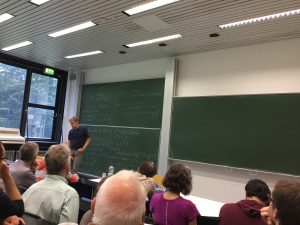
Hans-Bert Rademacher (Leipzig) proves that a simply connected, compact manifold of sectional curvature K≥1, which has a closed geodesic of length 2π, must be isometric to the round sphere.
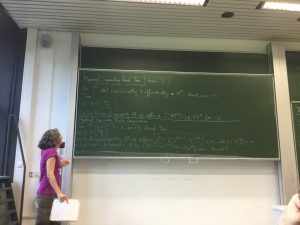
Catherine Searle (Wichita) discussed the “Maximal Symmetry Rank Conjecture”, which gives an upper bound for the dimension of an effectively acting k-torus on nonpositively curved n-manifolds. Joint with Christine Escher (Oregon) she proves this conjecture for the case that the dimension of the smallest orbit is 2k-n+1.
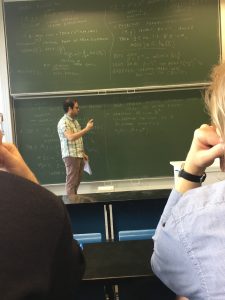
Ricardo Mendes (Köln) spoke about joint work with Marco Radeschi (Notre Dame), which solves some special cases of a conjecture from Marques-Neves-Schoen stating that for every Ricci-positive manifold M there is a constant C such that each minimal surface has index bigger than Cb<sub>1</sub>(M).
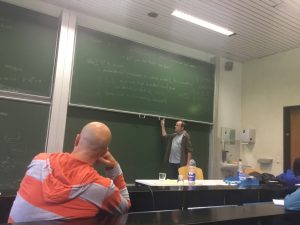
Wolfgang Ziller (Pennsylvania) discused positively curved Finsler metrics on the 2-sphere. Jointly with Bryant, Foulon, Ivanov, Matveev he shows that each such metric has a geodesic flow conjugate to one of the classical examples from Katok, and that such geodesic flows are conjugate iff the shortest geodesics have the same length.
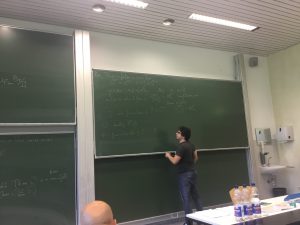
Marco Radeschi (Notre Dame) discussed Besse-orbifolds, i.e., orbifolds all of whose geodesics are closed. Joint with Carsten Lange (Köln) and Manuel Amann (Karlsruhe) he proves that odd-dimensional Besse-orbifolds with trivial orbifold fundamental group must actually be manifolds.
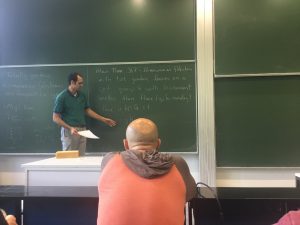
Llohann Sperança (Sâo Paulo) proved that for a compact Lie group with bi-invariant metric all totally geodesic Riemannian foliations are obtained by translating a subgroup into each base point.

David González (Madrid) discussed a converse to the Cheeger-Gromoll soul theorem, i.e. whether every vector bundle over a compact manifold at least stably admits a nonnegatively curved metric. Jointly with Marcus Zibrowius (Wuppertal) he gives a positive answer for positively curved homogeneous spaces.

Christoph Böhm (Münster) discussed the Ricci flow on homogeneous spaces that are a product of a compact space with a homogeneous metric on R<sup>m</sup>. Jointly with Ramiro Lafuente (Münster) he shows that the Ricci flow exists for all times and subconverges towards an expanding Ricci soliton.
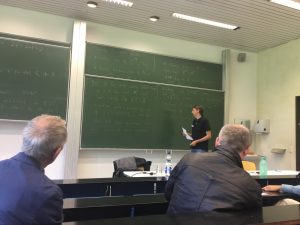
Frank Reidegeld (Dortmund) constructs for the first time G<sub>2</sub>-orbifolds with D<sub>4</sub>-, D<sub>5</sub>- or E<sub>6</sub>-singularities.
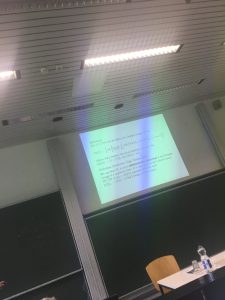
Jaime Santos (Madrid) discussed different approaches to lower Ricci bounds on metric measure spaces and proved with Luis Guijarro (Madrid) that one can find a bound on the dimension of the isometry group for spaces satisfying these conditions.

Brett Kotschwar (Arizona) talked about joint work with Lu Wang (Wisconsin) on shrinking gradient Ricci solitons. They prove that these solitons must be a Kähler cone whenever they are asymptotic to a Kähler cone.
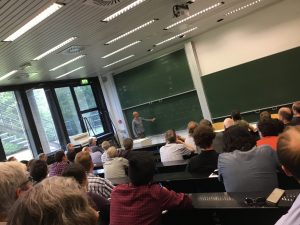
Alexander Lytchak (Köln) talked about joint work with Vitali Kapovitch (Toronto) and Anton Petrunin (Pennsylvania), in which they proved that the boundary of a convex body in R<sup>3</sup> has open geodesics in almost all directions and the Liouville measure is preserved by the geodesic flow.
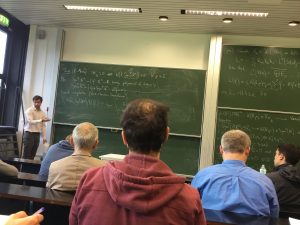
Renato Bettiol (Pennsylvana) discussed joint work with Ricardo Mendes (Köln) which provides an algorithm to decide existence of metrics of nonnegative sectional curvature.
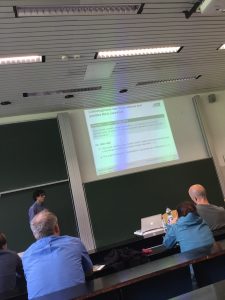
Diego Corro (Karlsruhe) constructs Ricci-positive metrics on simply connected n-manifolds with an effective action of an n-2-torus, for example, various connected sums of products of spheres.

Matthias Ludewig (Bonn) discussed operaors operators that up to terms of lower order are powers of the Laplacian. He defines a mass which is a global invariant but admits a local transformation rule.
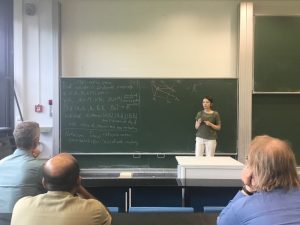
Nina Lebedeva (Petersburg) discussed the so-called (k,l)-dipol property, a certain length comparison property depending on parametrers k,l which yields obstructions to embeddability into a nonnegatively curved space. The (k,0)-dipol property is equivalent to nonnegative curvature. In joint work with Anton Petrunin (Pennsylvania) and Vladimir Zolotov (Köln) she proves that this also holds for the (2,2)- and (3,1)-dipol property, albeit not for (3,3) or (4,1).
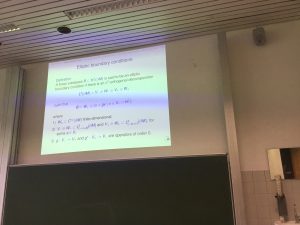
Christian Bär (Potsdam) discussed the Fredholm property of Dirac-operators on noncompact Riemannian (with Werner Ballmann, Bonn) and Lorentzian (with Alexander Strohmaier, Leeds and Sebastian Hannes, Potsdam) manifolds. In particular there is a Lorentzian version of the Atiyah-Patodi-Singer theorem.
For the German version with slightly more details see http://scienceblogs.de/mathlog/2017/07/28/curvature-and-global-shape-2017/.
